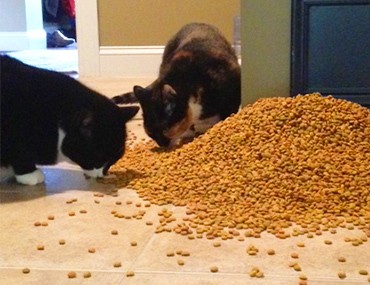Dr. Ernie Ward is the author of Chow Hounds: Why Our Dogs Are Getting Fatter – A Vet’s Plan to Save Their Lives (2010 HCI) and Founder of the Association for Pet Obesity Prevention. Visit Dr. Ernie at www.DrErnieWard.com or on Facebook.
Obesity is our pets’ number one health threat.
Today’s dogs and cats are living longer than ever before. Unfortunately, they’re also heavier than ever and have more costly chronic diseases. The good news is that many pet illnesses can be prevented. The bad news is that once a pet develops one of these long-term conditions such as arthritis or diabetes, there’s often no cure. I’m pushing for a new era of veterinary medicine focused on preventing diseases rather than simply treating them. When it comes to preventing disease and helping your pet live a long, healthy, pain-free life, there is perhaps nothing more important than what and how much you feed them. Trouble is, we’re feeding too much. Way too much. Over 55% of all US dogs and cats are estimated to be overweight or obese according to the latest study from the Association for Pet Obesity Prevention. Flabby felines and portly pooches are the new normal. Heavier pets are prone to a torrent of weight-related disorders. If your pet needs to shed a few pounds, consider these serious consequences of obesity as you’re looking for motivation.
Over 55% of all US dogs and cats are estimated to be overweight or obese according to the latest study from the Association for Pet Obesity Prevention. Flabby felines and portly pooches are the new normal. Heavier pets are prone to a torrent of weight-related disorders. If your pet needs to shed a few pounds, consider these serious consequences of obesity as you’re looking for motivation.
Decreased Life Expectancy
Less is more when it comes to feeding pets and living longer. Eating less has been proven to extend life expectancy and reduce suffering in species as diverse as worms, spiders, water fleas, fruit flies, fish, hamsters, mice, rats, dogs, and monkeys. In a 1999 longevity study conducted on dogs, researchers found dogs fed 25% fewer calories than normal lived an average of two years longer. Even more exciting was that the dogs fed a little less food had a lot fewer medical problems. The study dogs also required fewer medications and remained more active well into “old age.” If you’re looking for the Fountain of Youth for your pets, it’s right there in the food bowl.
Arthritis
The number one medical condition associated with excess weight is osteoarthritis (OA). Both large and small breeds of dogs are typically affected but cats are developing crippling arthritis at alarming rates. A March 2011 study concluded that the majority of cats (61%) had radiographic evidence of OA. Interestingly, few owners recognized the signs of arthritis, leading the study authors to strongly advise radiographs in older cats, especially those demonstrating inappropriate elimination or household “accidents.” If your pet is carrying as little as one or two extra pounds, remember those pounds are stressing tiny joints not designed to carry extra weight. Making matters worse, fat cells produce harmful chemicals known as adipocytokines that damage even non-weight bearing joints. There is no cure for arthritis; we can only minimize the pain.
Diabetes
Veterinarians are increasingly diagnosing overweight cats with type 2 diabetes. Similar to humans, chubby cats are at tremendous risk for developing high blood sugar and diabetes requiring twice daily insulin injections. Obese dogs are more prone to a condition known as insulin resistance, a state in which they have dangerously high insulin and blood sugar levels. Both diabetes and insulin resistance have been shown to reduce a pet’s life expectancy in addition to requiring constant medication and treatment. Type 2 diabetes is largely prevented by simply feeding the amount of food to maintain a normal weight. What could be easier?
High Blood Pressure
Sometimes we forget our pets get many of the same diseases we do. Hypertension is one of these commonly overlooked conditions in pets. High blood pressure is known as the “silent killer” because you can’t tell if your pet has it nor can you see the damage it’s causing – until it’s too late. If your dog or cat has packed on a few extra pounds, have its blood pressure checked by your vet. This simple test can help prevent sudden blindness, heart problems and kidney failure. Treatment is as simple as changing to a low-sodium diet, weight loss, increasing exercise, and medications in more serious cases.
Cancer
Excess fat has been implicated in the formation of many cancers in animals. The National Cancer Institute estimates that obesity and physical inactivity may account for 25% to 30% of the major cancers in humans: colon, breast cancer in postmenopausal women, endometrial, kidney, and cancer of the esophagus. New research points to obesity-related insulin resistance as a likely cause. While we don’t have as many dog and cat research studies to draw upon, the consensus is that excess weight increases a pet’s risk of developing many types of cancer. Reduce the weight to reduce the risk.
The trouble with being plump isn’t simply vanity; excess weight causes or worsens many serious medical conditions in our pets. Our animal companions depend on us to make good choices for them. Make sure you’re feeding your pet based on sound nutritional advice and not due to clever marketing or price. Talk with your vet about specific strategies to keep your pet at a healthy weight. Your pets will be happier, have fewer medical problems, and you’ll enjoy more years together.
If you have any questions or concerns, you should always visit or call your veterinarian – they are your best resource to ensure the health and well-being of your pets.
